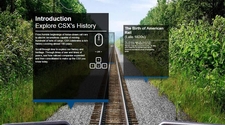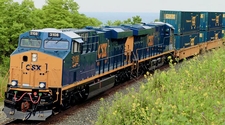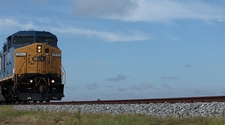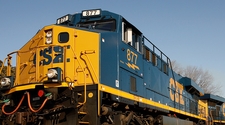| Package Car |
A car containing several less than carload shipments. |
| Package Freight |
Merchandise shipped in less than carload quantities. |
| Packer |
A large, motorized device, operated by a driver, used to lift trailers and containers onto or off of flat cars. |
| Packing List |
A detailed list of goods shipped. |
| Paid-In ""Amount"" |
The original freight charges from origin to original destination as outlined in the bill of lading which was prepaid. |
| Paired Trailer/Container |
A prepaid shipment consisting of two trailers/containers shipped to the same city for different consignees. For rating purposes, a special rate is allowed which is cheaper than the normal rate for two individual TOFC/COFC shipments. At destination, the trailers/containers are treated as individual shipments. |
| Palace of Justice |
Railroad business car. |
| Pallet |
A small portable platform, usually constructed of wood for holding material during storage or transportation. |
| Pantograph |
A device (located on top of electric locomotives) which collects power from an overhead contact wire by means of a sliding contact shoe. |
| Paper Rate |
A published rate under which no traffic moves. |
| Participating Carrier |
A transportation line which is a party, under concurrence, to a tariff or contract issued by another transportation line or agency. |
| Patron |
See Consignee. |
| Patron Code |
A six-digit code unique to a patron's local or billing address. |
| Pawl |
A pivoted bar on a car brake wheel adapted to fall into the notches or teeth of a wheel as it rotates in one direction, and to restrain it from backward motion. See Ratchet and Brake Ratchet. |
| Payment Documents |
Any papers submitted by the customer with a payment. Used by a bank to identify which bills the customer intended to pay. |
| Payment Due Date |
Fifteen days after the freight bill date required by STB regulations, postmark to postmark. |
| Payment Letter |
A form letter used in lieu of a phone call to notify a customer of delinquent freight bills. |
| PD Car |
Permanent Dunnage Car. A box car equipped with dunnage. OR A type of covered hopper where air pressure is used to unload the contents. |
| Penalty Application |
An automatic service application (emergency on Budd cars) of air brakes actuated by a safety control device. |
| Per Diem |
Latin phrase meaning for the day. |
| Per Diem Charge |
The amount which is paid by one carrier to another carrier for the daily use of its intermodal equipment. |
| Per Diem Reclaim |
A method of recouping car hire charges. |
| Per Diem Rules |
Rules established by agreement between railroads governing the hire of intermodal equipment. |
| Perishable |
Commodities easily spoiled or damaged because of weather or delay in transit, usually describing foodstuffs. |
| Permanent Dunnage Car |
See PD Car. |
| Permanent Magnet |
A magnet which retains a nearly constant value of magneto-motive force for an indefinite period. |
| Permeability |
A term used to express the ability of a substance, such as iron or steel, to carry magnetic lines of force. |
| PF Key |
A key on the computer terminal keyboard that is pre-defined to perform a specific function. |
| Phantom Signal Aspect |
An aspect displayed by a light signal, different from the aspect intended, caused by a light from an external source being reflected by the optical system of the signal. |
| Pickup |
A term descriptive of a car or cars added to a train en route between dispatching and receiving yards or cars added at dispatching yard to train operating over two or more divisions on a continuous work order. |
| PICL |
Perpetual Inventory Car Location. |
| PICL Clerk |
Employee who ensures waybills are placed in PICL rack and performs other clerical duties associated with train movement. |
| PICL Rack |
A piece of equipment that contains a pigeonhole for each track in a railroad yard into which keypunch cards and/or waybills are placed in their correct order as they actually appear on the track. |
| Pig (Slang) |
Trailvan shipment or trailer. |
| Piggy Packer |
Equipment used in the loading of piggyback trailers or containers onto flat cars. |
| Piggyback |
A term used to describe the hauling of loaded or empty highway trailers or containers on railroad flat cars. |
| Pigs |
Trailers and containers. |
| Pilot |
An employee assigned to a train when the engineer or conductor is not qualified on that segment of track. |
| Pin-Puller |
The person who uncouples cars while they are being switched. |
| Pinnacle |
A casting which is placed on top of a mast or post. |
| Piston Travel |
The amount of piston movement when forced outward as brakes are applied. |
| Pivot Pin |
See Knuckle Pin. |
| Placard |
Paper forms of various designs used to identify cars requiring special attention (i.e. Dangerous and Explosive). |
| Placard Boards |
The boards attached to freight cars to which placards are affixed. |
| Placarded Car |
A railcar placarded under requirements of the Department of Transportation regulations. |
| Placement |
When the car is actually placed in the industry by the railroad. |
| Plan Number |
A number, unique to intermodal traffic, which describes the mode of transportation used to move traffic, either strictly rail, rail-truck or combination of truck/rail/truck. |
| Plate |
A size indication found on the side of a car having to do with clearance dimensions. Explanations can be found in found in Equipment Register. |
| Plug Door |
A door on refrigerated or box cars which is flush with side of car when closed. To open, a lever mechanism is twisted until the door is disjoined, then the door slides down a track until the doorway is clear. |
| Plugged |
Term used to indicate that a track is full. |
| Pneumatic Dunnage |
Method of restraining lading by use of paper disposable inflatable dunnage or rubber multiple use bags. |
| Pneumatic Foot Valve |
A foot pedal or brake valve, which must be kept in a depressed position while the locomotive is operating. Any release of this device from its depressed position, after a time delay, initiates an emergency air brake application. |
| Point Detector Rod |
A circuit controller which is part of the switch operating mechanism and operated by a rod connected to a switch, derail or moveable point frog, to indicate that the point is within a specified distance of the stock rail. |
| Point of Entry (POE) |
A port at which foreign goods are admitted into the receiving country. |
| Point of Origin |
The station at which a shipment is received by a transportation line. |
| Point-to-Point Rate |
A rate that is published to apply from a specific origin to a specific destination. |
| Pole Changer |
A device by which the direction of current flow in an electrical circuit may be changed. |
| Pool Cars |
Specially equipped cars of different ownerships assigned to a specific company or location. |
| Pools |
See Equipment Pools. |
| Port of Entry |
A port at which foreign goods are admitted into the receiving country. |
| Positive Plate |
The grid and active material from which the current flows to the external circuit when the battery is discharging. |
| Power-Operated Switch |
A remotely controlled switch. It is operated electrically or electropneumatically. See dual-controlled switch. |
| Pre-Tested Train |
A train on which the air brakes have been inspected and tested prior to the addition of the outbound locomotive consist. Following addition of the outbound locomotive consist, an application and release test of the rear is required before departure. |
| Prepaid |
A term denoting that transportation charges have been or are to be paid at the origin point of shipment. |
| Prepaid Charges |
Amount of transportation and other charges accruing at point of origin or en route. |
| Prepaid Freight Bill |
A freight bill rendered by a transportation line at origin to the freight payor, giving a description of the freight, name of consignee, destination, weight, and amount of charges. |
| Prepaid Shipment |
A term indicating that freight charges have been, or are to be, collected by originating carrier at point of origin. |
| Prepay Only Station |
Station to which freight charges must be prepaid, usually a non-agency station. |
| Pressure Maintaining |
A feature of the automatic brake valve, which will maintain brake pipe pressure against brake pipe leakage during a service application. |
| Primary Cell |
A device for the direct transformation of chemical energy into electrical energy. |
| Prior Rights |
Term used to indicate that members of a craft have priority over jobs held on former railroads acquired by mergers or consolidations. |
| Prior-Prior Rights |
See Prior Rights. More than one merger applies. |
| Private Car |
A car having other than railroad ownership. |
| Private Carrier |
A transportation line not servicing the general public. |
| Private Rate |
Rate that has been developed for a particular patron or customer. |
| Private Siding |
A side track owned or leased by an individual or firm. |
| Pro Number |
Pro is the abbreviation of the word progressive. A pro number is usually applied by the agent on freight bills, waybills, etc. for control purposes as part of the accounting procedure. This is applicable on some properties. |
| Profile |
A template for waybilling in AWS. It contains repetitive information such as shipper, consignee, destination and commodity. |
| Profile Number |
A unique number that is assigned to a computerized profile template. |
| Proportional Rate |
A local tariff rate that can be used in conjunction with other foreign or other local tariff rates to create a combination rate. |
| Protective Services |
Services provided by the railroad to protect shipments from heat or cold and accounted for with an accessorial charge. |
| Public Delivery Track |
A track subject to use by the general public, with facilities for loading and unloading cars. (Also known as Team Track) |
| Publishing Agent |
A person authorized by transportation lines to publish tariffs of rates and rules for their accounts. |
| Pull |
Removal of a car from a particular location, usually a spot at an industry. |
| Pull the Pin (Slang) |
To uncouple a car or cars by pulling up the cut-lever attached to the coupler. |
| Push Button |
A circuit controller operated by pushing a button, to open or close a circuit. |
| Pusher |
An extra engine at the rear of a train used to assist a train in climbing a grade. |
| back to top |

















